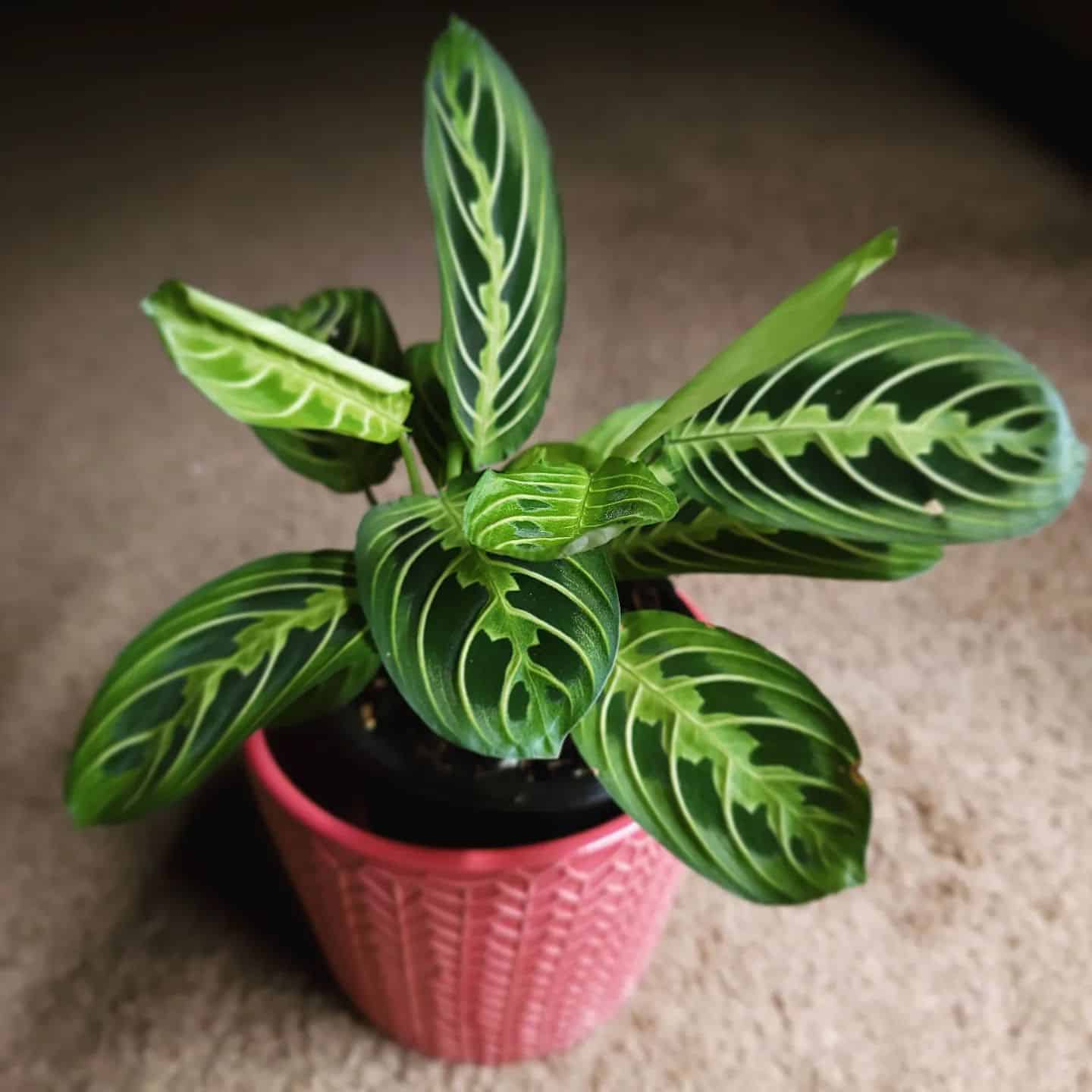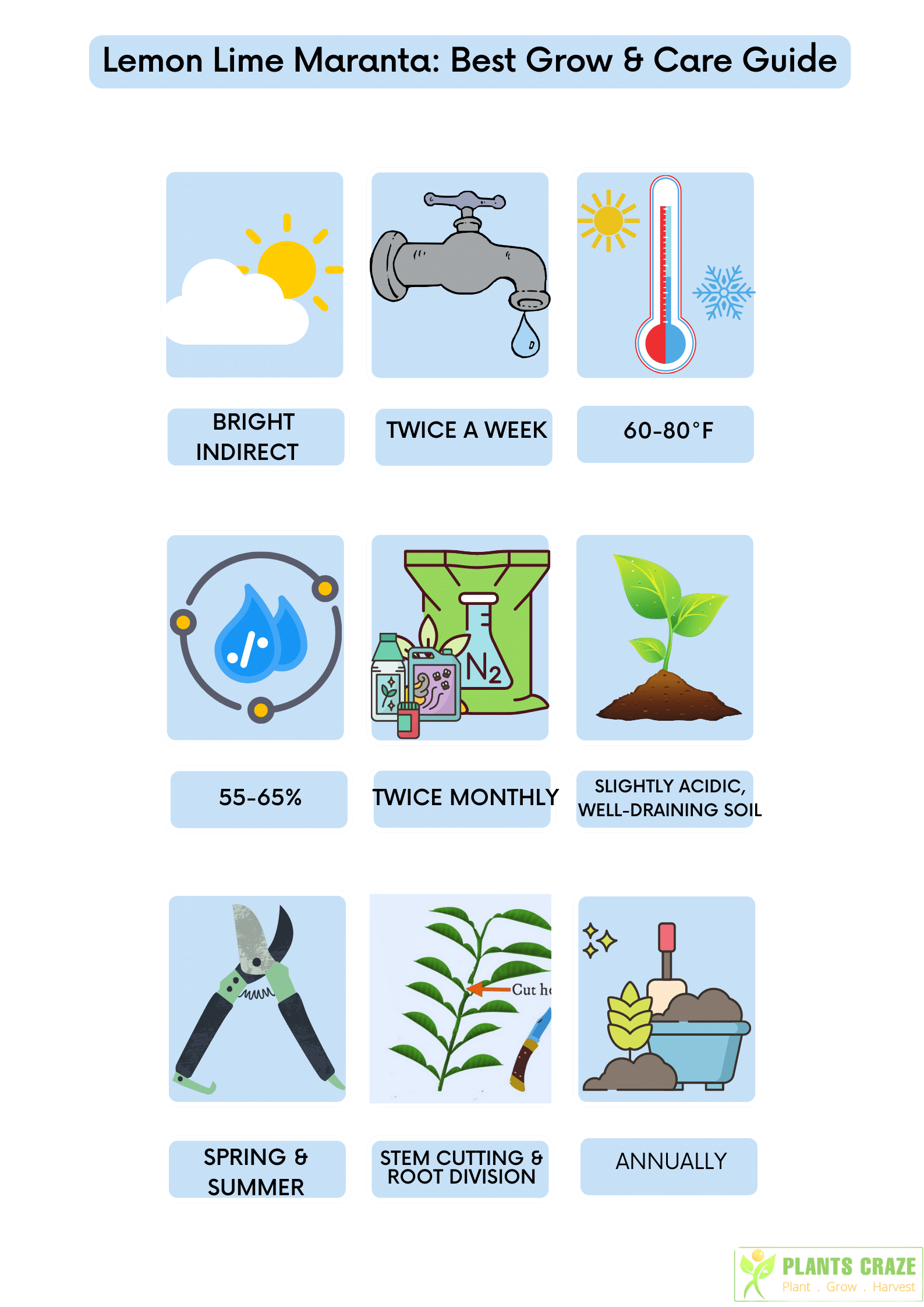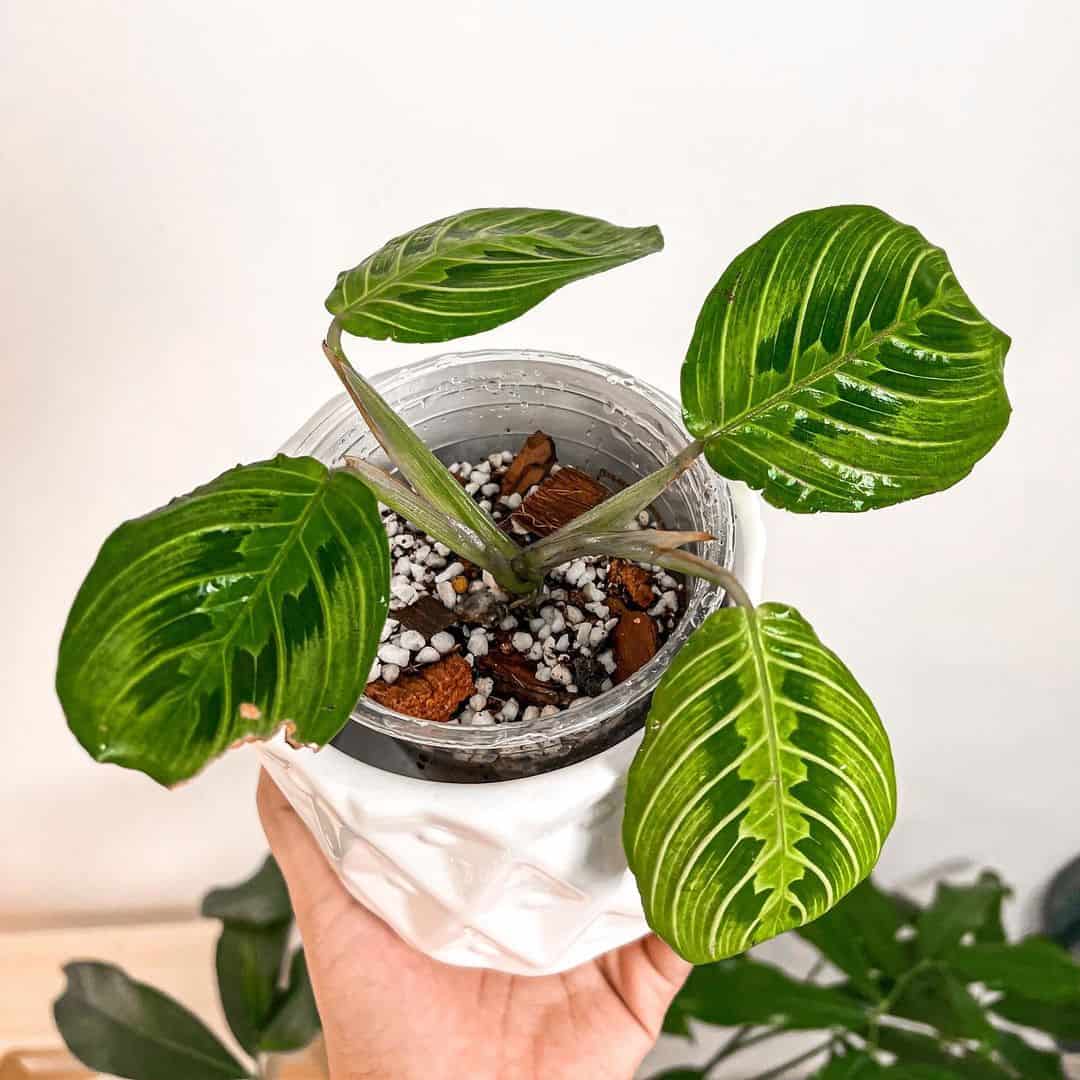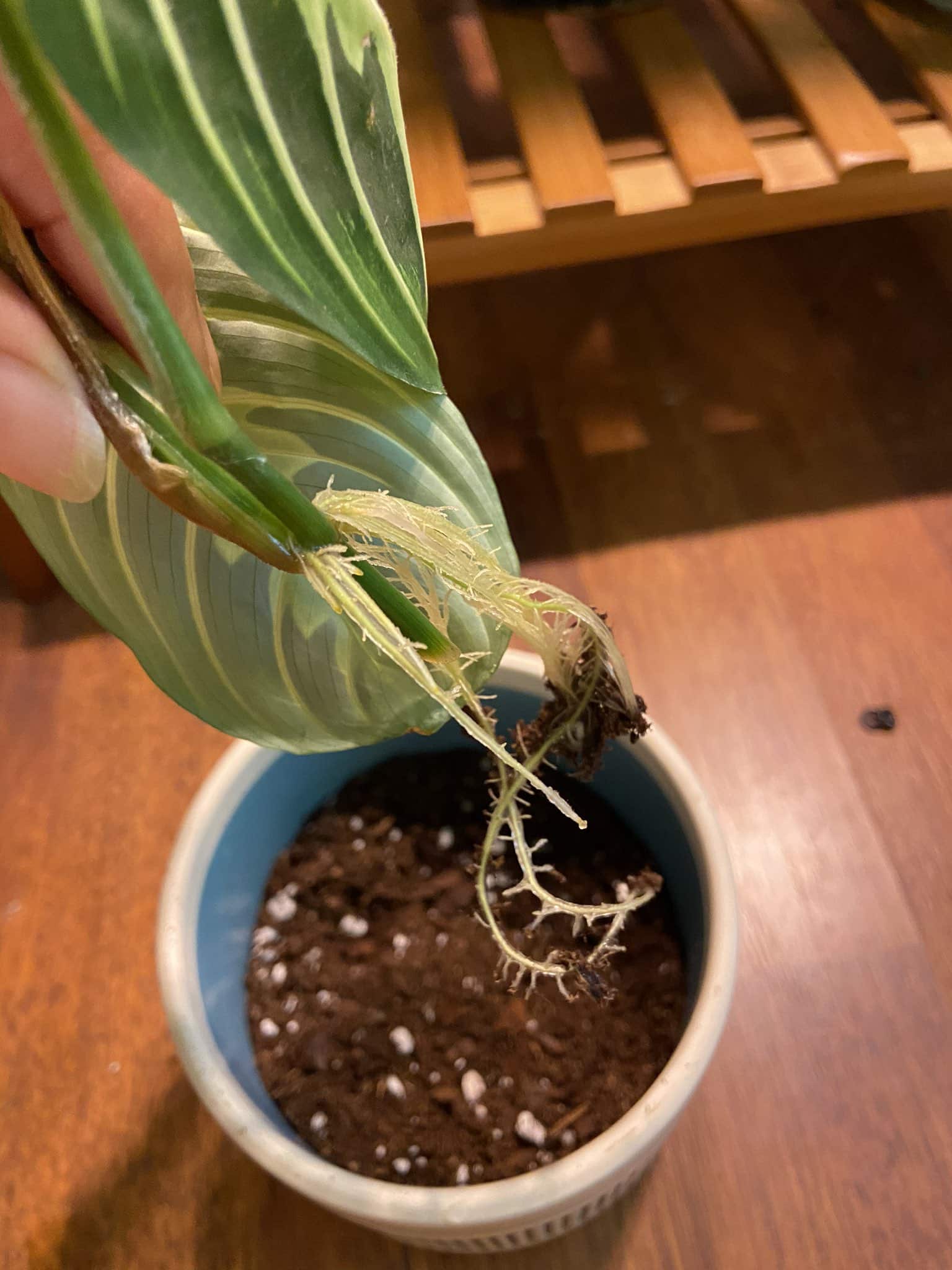The Lemon Lime Maranta is famous for its compactness and rareness among the Prayer Plants, with minimal requirements during growth.
Maranta is among fussy houseplants but may need reasonable care, so you should assign tropical conditions to make it thrive indoors.
Scroll down to learn the complete guide for Lemon Lime Maranta care.
Table of Contents Show
Overview of Lemon Lime Maranta
A native of the tropical forests of Brazil, Lemon Lime Maranta is a rare plant known as the Prayer Plant for its ability to open and close the leaves during morning and dusk.
| Indicator | Identity |
|---|---|
| Scientific Name | Maranta leuconeura Lemon Lime |
| Common Name | Green Prayer Plant, Prayer Plant Lemon Lime |
| Genus | Maranta |
| USDA Zones | 10 to 12 |
| Mature Size | 12 inches tall and 14 inches wide |
| Growth Rate | Slow |
| Foliage | Oval, elongated leaves with red veins upper side |
| Flowering | Purple white small flowers |
| Blooming Period | Spring and Summer |
| Plant Type | Rhizomatic perennial |
| Toxicity | Non-Toxic |
| Common Pests | Mealybugs, Spider Mites, and Thrips |
| Common Diseases | Brown Leaf Tips, Leaf Spot, and Root Rot |
Though belonging to the same family, Marantaceae, Calathea, and Maranta are not the same as they portray different leaf structures.

Also, Calathea does not show the opening and closing movements like Maranta. So be clear about the differences between Calathea and Maranta.
Lemon Lime Maranta Care and Grow Guide
Maranta plants thrive best in peat-based moist soil, dappled sunlight, shaded regions, and hot and humid conditions.

If the tips above are confusing, you can look for the detailed information below.
1. Sunlight & Temperature
Being a plant from a tropical region, the Maranta demands indirect light with prevention from the scorching bright light.
If the leaves fall under unfiltered light, your plants will undoubtedly suffer from bleaching and ultimate death.
And if the temperature rise collides with the light, the leaves might turn brown and droop down.
So keep the pot near shaded eastern windows, and for dark rooms, install grow lights.
Also, assign a heating mat under the pot and near heating vents as they are intolerant to temperatures below 55ºF.
2. Watering & Humidity
Lemon Lime Maranata prefers to be under moist soil with higher moisture in the air since they hate to be underwatered.
Also, avoid tap water, which contains chlorine and can turn the plant brown.
And try not to overwater the plant, as the leaves will wilt and turn brown with black roots due to rotting.
Alternatively, underwater plants show signs of drooping and drying if aided with low humidity, as the Lemon Lime Maranta is a moisture lover.
So better to use a humidifier beside the plant and check the 2-inch soil from the top before watering.
You can also use a pebble tray below the pot to maintain consistent humidity around the plant and group or place them in the bathroom and kitchen.
It is better to allow the soil to dry completely on winter days and provide watering once every 2-4 weeks as Marantas are dormant on cold days.
3. Soil & Fertilizer
Lemon Lime Maranta’s foremost priority is peat-based light, well-draining soil, as their roots need some airy space to grow.
You can create your DIY by mixing potting soil, perlite, and peat moss at a 1:1:1 ratio.

And to be safe, use a readily available commercial potting mix such as Lemon Lime Potting Mix, Miracle-Gro Mix, or Noot Organic Mix.
After creating the perfect soil, allow the plants to have enough food, as under-fertilized plant shows stunted growth with weakened and tilted stems.
But do not overfeed the Maranta, as they can show the symptom of yellowing and wilt in the basal leaves in no time.
Also, avoid fertilizer use in winter as the Lemon Lime Maranta shows slow or no growth.
4. Potting & Repotting
The slow-grower Maranta prefers to be root bound and stay in the same home till they mature.
So better to choose a 5-inch deep terracotta pot to make enough space and allow the prolific development of leaves before repotting.
Also, look for drainage holes, as the soil should not be soggy as it increases the chances of fungal growth and rotting.
Meanwhile, Lemon Lime Maranta rarely demands repotting with transplant only after the roots start to cover the drainage holes.
5. Occasional Pruning
Trimming also comes under Lemon Lime Maranta care demands as a “compulsory twice-a-year deal” during spring and fall and when you notice damaged, diseased leaves.
Your Maranta is prone to be attacked by pests like spider mites, thrips, and mealy bugs.
They leave out symptoms like white spots on the leaves and dew on the undersurface with holes and cuts on the leaves.
So, you can use sterilized scissors or pruners to cut off the damaged leaves or spray insecticidal soap and neem oil.
For that, trim off the diseased leaves just above the leaf node or snip them off with your fingers and trash them in the dustbin.
You can also spray fungicides like Bonide fungicide, Dr. Earth, and Monterey Concentrate Fungicide.
Lemon Lime Maranta: All About Growth Rate
The Lemon Lime Maranta is good in the hanging basket for its slow growth rate, taking up a height of about 12 inches.
The main focus of the Lemon Lime Maranta is yellow to light green variegation running down the spine of the oval leaves.

It is rare for Maranta to flower indoors, but not impossible if you meet the natural growing conditions.
And if you get lucky, you might enjoy bilaterally symmetrical white to purple flowers similar to snapdragons in summer after they reach maturity in about five years.
However, foliage lovers might cut off the buds, shifting the plant’s energy to leaf and stem growth.
Toxicity of Lemon Lime Maranta
Be safe to bring the Lemon Lime Maranta to your home, as they are non-toxic to humans, cats, and dogs.
However, do not let them chew on it as the elegant look of the plant may get affected, and the plants are not a good option for your pet’s stomach.
And some might be allergic to Lemon Lime Maranta, so better to stay on the safe side and contact the emergency helpline if consumed accidentally.
Propagation Methods for Lemon Lime Maranta
You can perform the propagation in early spring indoors or outdoors as long as the air is dry and the plant receives enough light.
1. Root Divisions
Propagation via roots is one of the easiest and fastest ways but demands gentle and careful handling from your side.
- Firstly, water the soil before removing the plant to prevent hurting the roots.
- Pull out the plant holding the stems and tuck off excess ground soil. Look out for any brown, damaged roots to remove them.
- Divide the root balls with your hands or sterilize tools like gardening knives and scissors.
- Leave some leaves on the stem to allow the section to act as a sole independent plant.
- Next, fill pots with moist soil and peat moss and place the section in separate pots.
- Lastly, keep the plant warm and shaded with daily misting till germination.
2. Stem Cuttings
Stem propagation is easier and safer than rooting as it offers more growing mediums, including water and soil.
- Choose a healthy plant that can offer enough stems to cut.
- Take out the stem three inches above and half inches below the node.
- Allow callous to form over the cut portion to prevent the attack of pests and diseases.
Propagation in Water
Start by filling a glass with distilled water and keep the cutting dipped inside, leaving the leaves above the water level.
- You can trim off excess leaves from the cutting and leave about two leaves on the top to focus on root development.
- Change the water every two days to prevent the decay of the stem.
- Next, transplant them into the pot with peat-based good drainage soil once the root reaches 1 inch long.
Propagation in Soil
You can dip the cuttings in rooting hormones before planting them to boost root development.
- Firstly prepare a potting mix with an equal quantity of perlite, potting soil, and coconut coir and fill the pot.
- Then, place the cutting dipped-in hormones into the mix.

- Next, cover the pot with a plastic cover having a few holes to capture the moisture within the container with optimum airflow.
- Lastly, maintain the temperature around 65-75ºF till the root develops and water them occasionally.
3. Seed Propagation
While propagating from seeds is time-consuming, getting hold of seeds of Lemon Lime is even more difficult.
However, seed propagation is not impossible if you get your hands on online stores for seeds.
- Prepare a pot by filling it with the potting mix per the abovementioned detail.
- Spread the tiny brown seeds of Maranta over the soil and spray them lightly with potting mix.
- After spreading, cover the pot with a plastic cover containing holes to allow airflow and capture moisture.
- Lastly, place the container near a warm, bright area at 60-75ºF.
Lemon Lime Maranta for Sale
Look for the sites below to bring the new Lemon Lime Maranta home.
| Place To Buy | Shipping Time |
|---|---|
| Bloomscape | 2-5 days |
| Etsy | 1-3 days |
| Amazon | 2-3 days |
| Midrib Plants | 3-5 days |
If you wish to add Maranta’s cousins to your home, choose anyone from 15 types of Prayer Plants.
From Editorial Team
The amalgam-patterned foliage of the Lemon Lime Maranta adds a fantastic look to any landscape.
Also, add a bit of tropicality to the Lemon Lime Maranta care checklist with partial shade in extreme afternoons to enjoy it as a tabletop or desktop plant.
